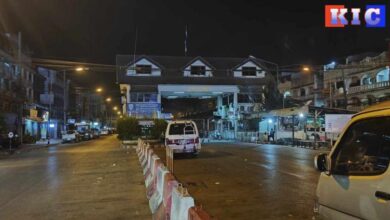2,000 Civilians Flee Burma Army Attacks

More than 2,000 civilians have fled a Burma Army offensive in Shan State, with shelling in village areas and reports of government soldiers engaging in looting, forced labour and torture, a human rights group has said.
The Burma Army attack, which allegedly involved more than 1,000 government troops, led to the attacks of village areas in Nawng Khio Township over the course of two days – March 1 and 2. The Shan Human Rights Foundation (SHRF), which has monitored human rights violations in Shan State for 14 years, alleged that the Burma Army then proceeded to torture one villager and loot livestock.
“This is unacceptable behavior from the Burmese government,” Nang Kwarn Lake, a spokesperson from SHRF, said in an interview with Karen News, adding, “the Burma Army attacked a ceasefire area – the Shan State Army-North (SSA-N) have agreed to a ceasefire with the Burma Army in this area. There are no Shan soldiers in that area where the Burma Army attacked.”
The Shan Human Rights Foundation claims Burma Army soldiers – from battalions 520, 77 and 115 – entered Si Ku and Pang Tee village tract areas on February 26 setting up camp and promising that no harm would come to local villagers.
SHRF said that despite the Burma Army promises soldiers looted the villages, seizing chickens, pigs and rice, shooting the livestock with guns, and then started firing mortar shells and guns into the village areas without warning on March 1st.
“Beginning on March 1st, the Burmese troops stationed around the eleven villages in Si Ku and Pang Tee tract started firing mortar shells and guns into the villages without warning. There were no Shan troops in the villages, and there was no return gunfire, but the Burmese troops kept firing until March 2nd.” The SHRF report stated, noting that fortunately there were no causalities caused by the attacks.
It is also alleged that the Burma Army forced a villager to act as a scout for a patrol and severely beat up another villager, who is still in its custody.
According to the SHRF report , the Burma Army soldiers found a villager with a walkie-talkie and accused him of working with the SSA-N – they proceeded to arrest and interrogate the man, who was beaten so severely that “many of his teeth were knocked out,”
The SHRF report that the man left in a basket overnight. “The next day he was taken away by the soldiers and handed over to police in Nawng Khio. He remains in custody.” A villager and victim of the offensive, cited in the SHRF report claims that the villagers were civilians.
“We are ordinary people. We have no guns. There was no reason to shoot into our village. There were no Shan soldiers there. They had already withdrawn before the Burmese soldiers arrived, so why did they shoot?”
Nang Kwarn Lake maintained that Burma’s government was putting the fragile peace process at risk by launching its offensives.
“The Burmese government is contradicting itself – they say they want peace but then engage in ongoing human rights abuses and military attacks in ceasefire areas, including using forced porters, and attacking villagers in places where there are no Shan soldiers. The Burmese government must stop these abuses.”
Nang Kwarn Lake argued that other factors such as mega-projects were also stoking ethnic conflict.
“The attacks occurred very close to an oil and gas pipeline, so the Burma Army is active in areas near projects – just like with the Kunlong Dam project,” Nang Kwarn Lake said.
Nang Kwarn Lake said that the government must exercise caution in pushing its development agenda.
“Before the political settlements has been reached, the Burmese government must also stop all the development projects, the main drivers of the instability/conflicts and that undermine the current peace process.”
Kunlong Dam, Burma’s first dam to straddle the Salween River and located near the strategic Sino-Burma border, was criticized in a February report by SHRF that the project had led to the displacement of more than 20,000 villagers, had increased militarisation and had contaminated local water supplies.




